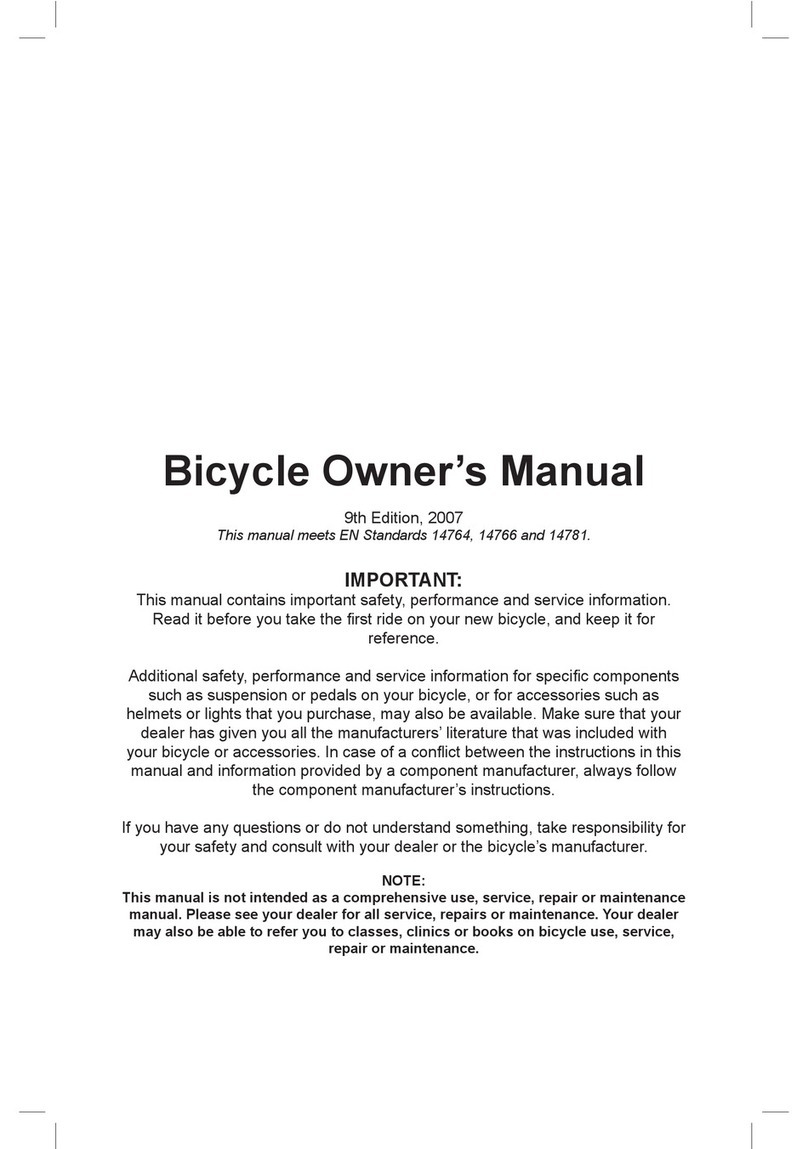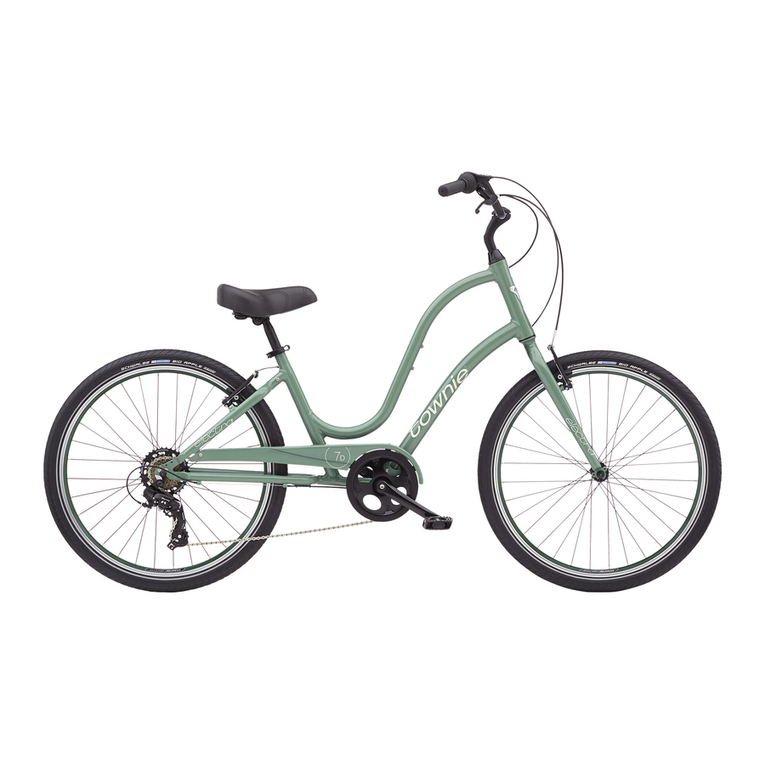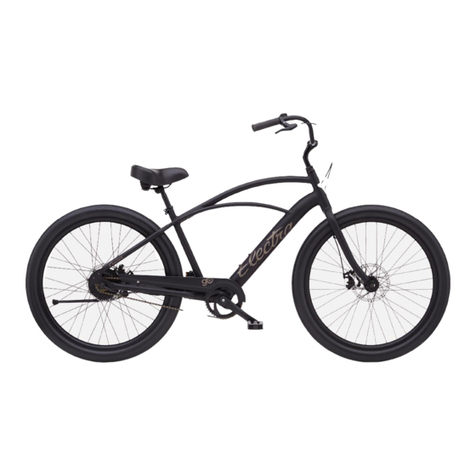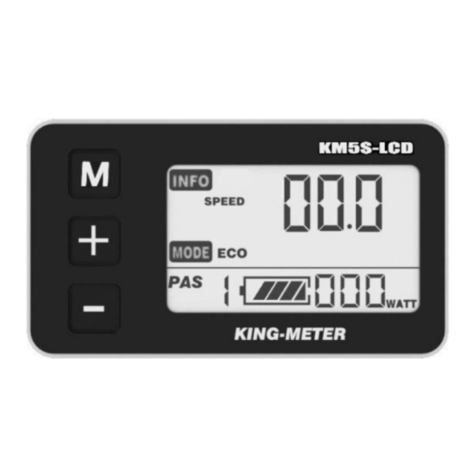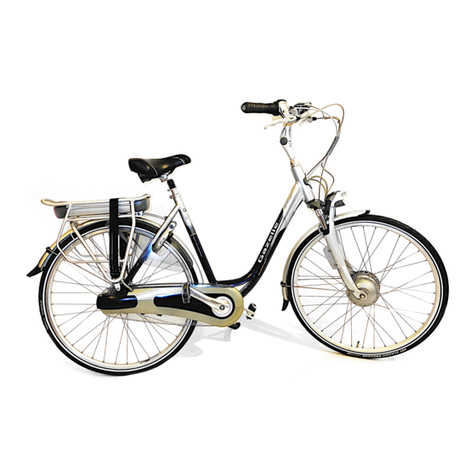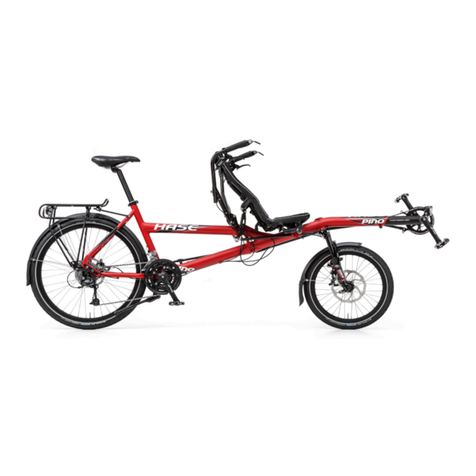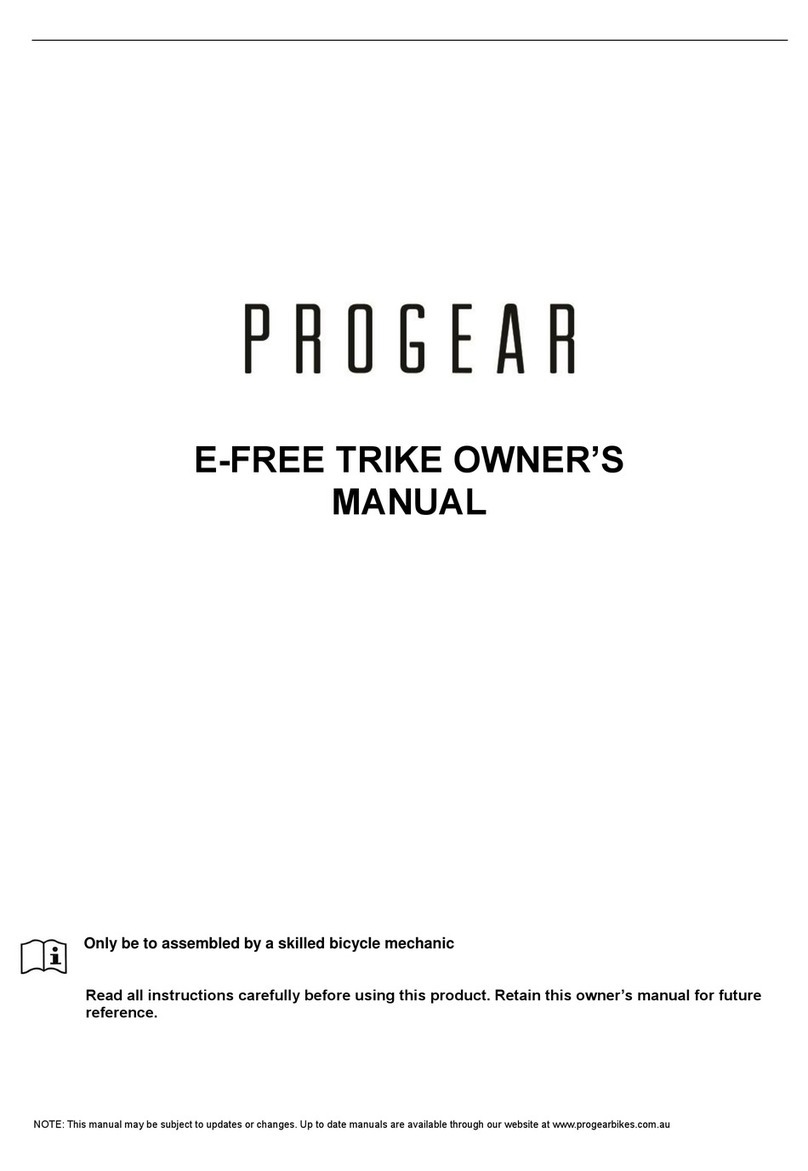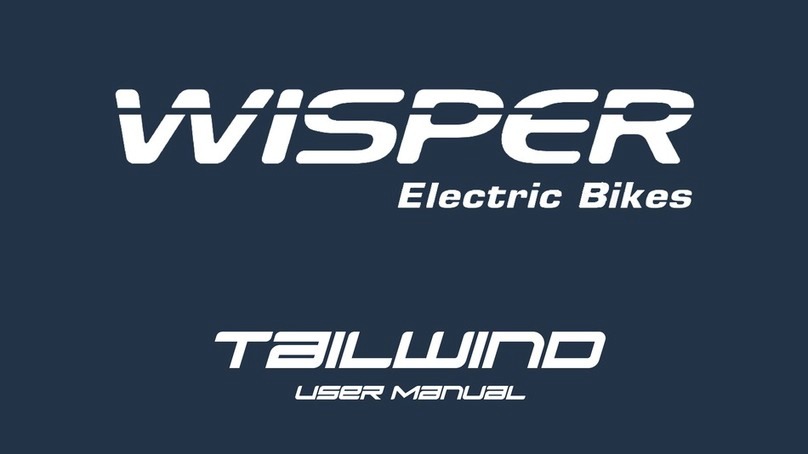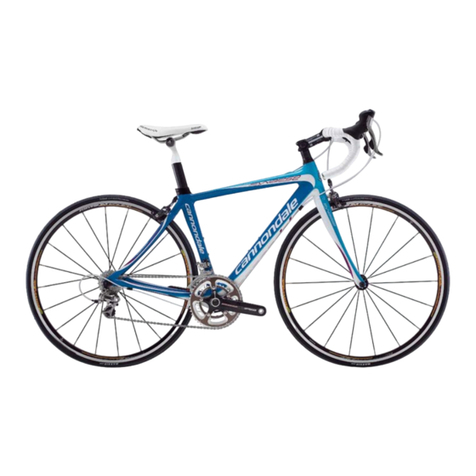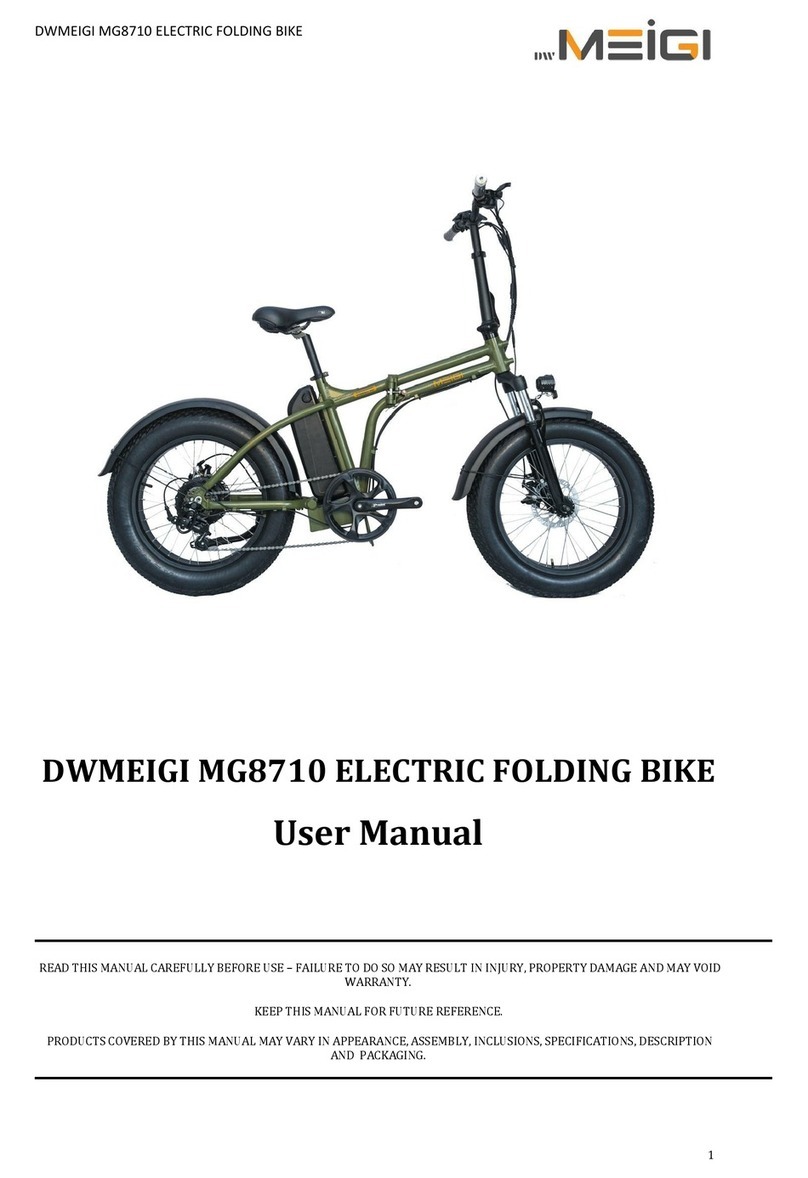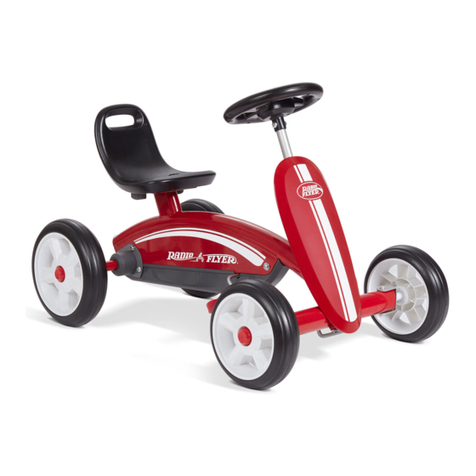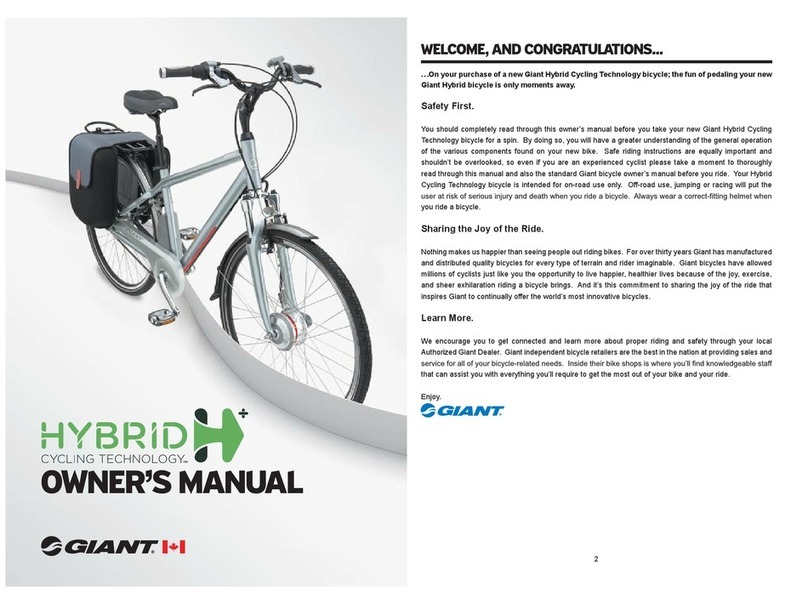Electra Townie GO! User manual

OWNERS MANUAL
Even if you have ridden a bicycle for years, it is important for
EVERY person to read Chapter 1 before you ride your new bicycle.

Keep this manual with the
bicycle
This manual is considered a part of the bicycle
that you have purchased. If you sell the bicycle,
please give this manual to the new owner.
Register your bicycle
Bicycle registration is the only record we have
of who owns this bicycle. If it is necessary to
give you new instructions, your registration will
provide us with your contact information. If you
choose to not complete the registration, make
sure you check frequently for new information
on the Electra web site. Also, registration and
proof of purchase are necessary to make a
warranty claim.
It is easy to register on the Electra web site.
Choose the web site for your country. If you
cannot find one for your country, use the web
site for the U.S.:
http://www.electrabike.com/support/product-
registration
If you have questions
There are many models of Electra bicycles with
a variety of equipment, so this manual might
contain some instructions that do not apply
to your bicycle. Some illustrations might be
different from your bicycle. For updates to this
manual, visit the Electra website.
If you have questions after you read this manual,
consult your retailer. If you have a question or
problem that your retailer cannot answer or
repair, tell us:
Electra Bicycle Company
Attn: Customer Service
1010 South Coast Highway 101
Suite 101
Encinitas, CA 92024 USA
800.261.1644
Table of Contents
Important: Keep for future reference
Meaning of safety signs and language ............. 1
Foreword: Bicycles, accidents, and safety ....... 1
Chapter 1: Guide to safe on- and
o-road operation
Life span of a bicycle
and its parts ............................................................... 3
Pre ride checklist ...................................................... 4
Rules to ride safely .................................................. 7
Riding instructions...................................................9
Safeguard your bicycle ..........................................11
Warning about mechanical work .....................12
Townie GO! ...............................................................13
Use conditions ....................................................... 14
Chapter 2: Maintenance
Maintenance schedule .........................................15
Chapter 3: Inspection and adjustment
A word about torque specifications ............... 16
Handlebar and stem ..............................................17
Saddle (seat) and seatpost ................................ 18
Derailleurs ............................................................... 20
Internal gear systems ............................................21
Shift levers ................................................................22
Brake levers ..............................................................22
Brakes .........................................................................23
Wheels ......................................................................26
Reflectors ................................................................. 30
Cables .........................................................................31
Crankarms and bottom bracket ........................31
Headset ......................................................................31
Pedals ..........................................................................31
Chain ..........................................................................32
Luggage carriers .....................................................32
Training wheels .......................................................32
Accessories ..............................................................33
Frameset (frame and fork) .................................33
Chapter 4: Lubrication ..................................35
For more instructions .......................................36
Warranty .....................................................................36

Important: Keep for future reference
Even if you have ridden a bicycle for years, it is important for
EVERY person to read Chapter 1 before riding this bicycle!
This manual shows how to ride your new bicycle
safely. Parents should explain Chapter 1 to a
child or person who might not understand this
manual, especially regarding safety issues such
as the use of a coaster brake.
This manual also shows you how to do basic
maintenance. Some tasks should only be done
by your retailer, and this manual identifies them.
Meaning of safety signs and
language
In this manual, the Safety Alert symbol, a
triangle with an exclamation mark, shows a
hazardous situation which, if not avoided, could
cause injury. The most common cause of injury
is falling off the bicycle. Even a fall at slow speed
can cause severe injury or death, so avoid any
situation with the special markings of a grey
box, safety alert symbol, and these signal words:
‘CAUTION’ indicates the possibility of mild
or moderate injury.
‘WARNING’ indicates the possibility of
serious injury or death.
This manual complies with these standards:
• ANSI Z535.6
• AS/NZS 1927:1998
• BS 6102 : Part 1: 1992
• CEN 14764, 14765, 14766, 14781, 14872,
16054
• CPSC 16 CFR 1512
• ISO 4210 Parts 1-9 and ISO 8098
Foreword: Bicycles,
accidents, and safety
A bicycle can be fun when used for
transportation, recreation, exercise, or
competition. But a bicycle can also be
dangerous, especially if you try to ride beyond
the limits of your bicycle or the limits of your
ability. The skill or ability of a bicycle rider can
vary greatly, just like the skill of an automobile
driver or a skier. Do not ride in a manner that
exceeds your ability.
Each bicycle also has limits because of many
properties. This is a partial list:
• Design and materials of the bicycle
• Maintenance of the bicycle
• Use of the bicycle: surface, speed, etc.
• Surface of the road or trail
If your bicycle is involved in any kind of impact,
crash, or accident, have it inspected thoroughly
by your retailer before you ride it again.
A bicycle cannot protect you in an
accident
Bicycles are not designed to withstand
every situation. In a crash or impact, it is not
uncommon for the bicycle to have damage and
for you to fall. If you fall, your bicycle can not
prevent injury. Cars have bumpers, seat belts,
air bags, and crumple zones. Bicycles do not,
so even a small crash at slow speed can cause
injury or death.
Think safety
Always “Think Safety” and avoid dangerous
situations, which are usually obvious. However,
not all dangerous situations are obvious. Many
of those are shown in this manual; read at least
Chapter 1 before you ride.
Some of the high-risk stunts and jumps seen in
magazines or videos are very dangerous. Even
skilled athletes get severe injuries when they
crash (and they do crash).

2
Chapter 1: Guide to safe on- and o-road operation
This chapter explains important things you should know
before a first ride, including safety information that is
important to follow on every ride.
Bicycle t
Your retailer will help you find a bicycle that has
the correct dimensions for your body. There
should be a minimum standover clearance of
at least 1” (25 mm) between the top tube and
you when you stand over your bicycle (Figure
1.1). For a mountain bicycle, we recommend 2-3”
(50-75 mm) clearance.
You can adjust the saddle and handlebar to
offer the best comfort and performance. Before
you make these adjustments, read Warning
about mechanical work on page 12, then refer
to Chapter 3.
Your bicycle has a weight limit. See Use
Conditions on page 14. If you are not sure of
the weight limit on your bicycle and its parts,
consult your retailer.
Know how your bicycle operates
The properties of your bicycle, if not used
correctly, can decrease your control of the
bicycle. Before you ride fast or in conditions
that are a challenge, learn the operation
and performance of all the mechanisms of
your bicycle, especially brakes and steering
components. Practice the first use of your
bicycle at slower speeds in a flat, empty parking
area. Practice again after any change to your
bicycle.
If your bicycle does not operate as you need,
or if different parts are necessary for the safe
operation of your bicycle, it may be possible to
customize it. Consult your retailer.
‘Toe Overlap’
Some modern, high-performance bicycles,
especially smaller sizes, use a short-wheelbase
design with the front wheel close to the pedals.
When the handlebar is turned during very slow
speeds, your foot or toe-clips could overlap or
touch the front wheel or fender (Figure 1.2).
This overlap is affected by the size of your feet,
the length of the crankarms, the size of the tires,
and the pedals you choose. If you change any of
these components, the amount of the overlap
could change.
WARNING: If your foot or toe-clip touches
the front wheel or fender, ‘toe overlap’ could
decrease your control and cause you to fall.
Do not pedal when you turn at slow speed.
Powerful brakes
The power of bicycle brakes changes with the
Use Condition of the bicycle. Many models of
modern brakes are very powerful; they are made
to stop a bicycle in wet or muddy conditions. If
it is necessary for your bicycle to have more—or
less—power to stop, consult your retailer about
brake adjustments or other brake options for
your bicycle. Also read Braking on page 9.
Chapter 1: Guide to safe on- and off-road operation
A
FIGURE 1.1
A = Minimum standover
clearance
1” (25 mm) for most bicycles
2-3” (50-75 mm) for
mountain bicycles
FIGURE 1.2
Toe overlap

3
Sharp points, moving parts,
hot spots, and pinch points
Some parts of your bicycle can injure you if
mishandled. Sharp points include the teeth of
the chainrings and some pedals. Brakes and
their parts get hot. Moving parts can cut skin
and even break bones. Clamps and pivoting
parts such as brake levers can pinch, as can the
chain where it runs on to sprocket teeth.
Frame or fork problem
Frame problems are not common. As an
example of such a problem, some riders could
get a “shimmy” or “harmonic oscillation” or
“frame wobble” at some speeds.
If you get a shimmy or any other problem,
decrease your speed immediately and do
not ride the bicycle. If your bicycle behaves
in an unusual manner or you hear a noise,
immediately stop the bicycle and identify the
problem. After any impact, have your retailer
inspect the entire bicycle thoroughly. Repair any
problem before riding again, or take the bicycle
to your retailer for service.
WARNING: A frame or fork problem could
decrease your control and cause you to fall.
If your bicycle gets a shimmy or any other
problem, decrease your speed immediately.
Take your bicycle to your retailer for
inspection and service.
Life span of a bicycle
and its parts
Bicycles are not indestructible, and their parts
will not last forever. If your use of a bicycle
increases the forces on it through hard riding,
difficult conditions, or increased mileage, you
should replace your bicycle or its parts more
frequently than riders who ride less or ride
smoothly and carefully.
The safe life of a part is determined by its
construction, materials, use, maintenance,
rider weight, speed, terrain, and environment
(humidity, salinity, temperature, etc.)—so it is
not possible to give an accurate timetable for
replacement. Any form of crack, scratches, or
change of color in high-stress areas indicate
that the life of the component has been reached
and the part should be replaced. If you are not
sure if you should replace a part, consult your
retailer.
In some cases, a lighter frame or part has a
longer life than a heavier one. However, better
maintenance, more frequent inspections, and
more frequent replacement are necessary for a
light-weight, high-performance bicycle and its
parts.
WARNING: A bicycle is subjected to
wear and high stress. Different materials
and components may react to wear or stress
fatigue in different ways. If the design life of a
component has been exceeded, it may suddenly
fail, possibly causing injuries to the rider.

4
Chapter 1: Guide to safe on- and off-road operation
Pre ride checklist
The checklist that follows shows critical areas for you to
check before every ride.
If a part of your bicycle does not function
correctly, use the instructions in this manual to
repair your bicycle, or take your bicycle to your
retailer for service. Do not ride a bicycle with a
part that is damaged; replace the part.
This is not a complete maintenance program.
WARNING: A bicycle that does not operate
correctly can decrease your control and cause
you to fall. Fully check all of your bicycle
before each ride, and do not ride your bicycle
until you correct any problem.
✔Check the seat and seatpost
Make sure the saddle is correctly attached. Try
to turn the saddle and seatpost in the frame, and
try to move the front of the saddle up and down.
The saddle should not move or be loose.
If you choose to adjust the position of the
saddle, also follow the inspection procedures in
Chapter 3.
✔Check the handlebar and stem
Make sure the stem is correctly attached. It
should be in alignment with the front wheel and
correctly attached to the fork and handlebar. To
check the attachment, try to turn the handlebar
from side to side while you hold the front wheel
between your knees (Figure 1.3). To check the
connection of the handlebar, try to twist it in the
stem. The handlebar should not move or be loose.
Make sure that no cables are pulled or caught
when you turn the wheel from side to side.
Make sure grips are secure and that the ends
of the handlebar are covered or that plugs are
correctly inserted into the ends of the handlebar.
WARNING: A handlebar end that is not
plugged or covered can cut in a crash. Parents
should regularly inspect a child’s bicycle. Reinstall
or replace loose, damaged, or missing grips.
✔Check the frame and fork
Closely examine your frame and fork, especially
near junctions of the tubing, and clamping or
attachment areas. Look for signs of fatigue
stress:
• Dents • Cracks
• Scratches • Deformation
• Discoloration • Unusual noises
✔Check the wheels
Check the tire inflation. Inflate the tires to the
air pressure recommended on the sidewall of
the tire. If a lower recommendation applies to
the rim, inflate to the lower value.
WARNING: Excess air pressure can cause
the tire to explode off the rim, causing
permanent hearing loss or, if riding, a loss
of control. Use a hand pump with a reliable
pressure gauge, and do not overinflate.
Make sure the wheels are straight. Turn the
wheel and check the rim when it goes through
the brake-pads or the frame. The rim should not
wobble up and down or from side to side.
Make sure the wheels are attached correctly.
Lift your bicycle and hit the top of the tire with
a solid blow (Figure 1.4). The wheel should not
come off, be loose, or move from side to side.
Your bicycle may use one or more systems to
attach the wheels to the frame (Figure 1.5). For
instructions about adjustment and closure of the
wheel attachment devices on your bicycle, and
additional inspection specific to those devices,
see Chapter 3.
FIGURE 1.3
Function test for the
handlebar and stem

5
Make sure the cables and housing are properly
secured to the frame or fork so that they cannot
interfere with or get caught on moving parts.
WARNING: A brake system that is dirty,
worn, damaged, or not adjusted correctly
could decrease your control and cause you
to fall. Make a full inspection of the brakes
before each ride. If your brakes do not
operate correctly, do not ride your bicycle.
Adjust the brakes or take your bicycle to your
retailer for service.
Hand-rim brake: Pull the lever to make sure
the brake moves freely and stops your bicycle.
If the lever can be pulled to the handlebar, the
brake is too loose. The brake-pads should be
in alignment with the rim surface (Figure 1.6).
When the brake is not applied, the brake-pads
should be 1 to 2 mm from the rim. If the brake-
pads are too near the rim, the brake is too tight.
Disc brake: Pull the lever to make sure the brake
moves freely and stops your bicycle. If the lever
can be pulled to the handlebar, the brake is too
loose. When the brake is not applied, the brake-
pads should be 0.25-0.75 mm away from the
disc. If the pads are too near the disc, the brake
is not in alignment or the brake is too tight. With
a hydraulic brake system, there should be no
leaks of brake fluid.
CAUTION: A disc brake and disc get very
hot during use and could burn skin. Also, the
disc edges can be sharp and could cut skin.
Do not touch the disc or disc brake when hot
or when the disc turns.
If you are not familiar with the attachment
devices on your wheels, we also recommend you
ask your retailer to demonstrate them for you.
WARNING: A wheel attachment device
that is not correctly adjusted and closed
can allow the wheel to be loose or come
off, suddenly stop the wheel, decrease your
control, and cause you to fall. Follow the
instructions in Chapter 3 to make sure the
wheels are correctly attached before you ride
your bicycle.
✔Check the brakes
Use the inspection instructions for the type of
brake(s) on your bicycle:
• Hand-rim brake: a cable connects a hand
lever to the brake. The lever causes the brake-
pads to apply pressure to the rim
• Disc brake: a cable or hydraulic hose connects
a hand lever to the brake. The lever causes
the brake to apply pressure to a disc attached
to the wheel hub.
• Internal hub brake: a cable connects a hand
lever to a mechanism inside the hub.
• Coaster brake: when you move the pedals to
the rear, the brake engages.
FIGURE 1.4
Test for loose condition
FIGURE 1.6
Brake pad alignment
1. Brake-pad in alignment
with rim surface
2. Pad and rim should
be parallel, with 1-2 mm
clearance
3. Direction that the rim
turns
4. 0.5-1.0 mm toe-in
1
2
3
4
FIGURE 1.5
Wheel attachment types:
1. Quick release
2. Nutted axle
3. Threaded skewer (with
hex wrench)
1
3
2

6
Internal hub brake: Pull the lever to make sure
the brake moves freely and stops your bicycle.
If more than 15 mm (5/8”) of lever movement
is necessary to stop your bicycle, the brake is
too loose. If less than 7 mm of lever movement
stops your bicycle, the brake is too tight.
CAUTION: An internal hub brake gets very
hot during use and could burn skin. Do not
touch the hub or cooling fins when hot.
Coaster brake: The brake should engage before
the crankarms turn 60 degrees (1/6 turn). The
chain operates the brake, so make sure the
chain has the correct tension so that it can not
fall off. There should be between 1/4 to 1/2”
(6-12 mm) total vertical movement of the chain
(Figure 1.7).
✔Check the lights and reectors
Make sure all reflectors are clean and in their
correct position. Also make sure the reflectors
are not covered or obstructed by clothing or
anything on your bicycle.
Make sure any lights operate correctly and
that batteries are charged. If the lights use a
dynamo, make sure the dynamo is mounted
correctly and cannot move.
Some countries, localities, or governments have
specific requirements for lights, such as colors or
types. Check before traveling with your bicycle.
WARNING: A bicycle without correct lights
and reflectors might be difficult for other
people to see, and you might not be able to
see. If you can not see, or other people can
not see you, you could have an accident. In
low visibility conditions, use a front light, a
rear light, and reflectors.
✔Check your tandem
Check both saddles and handlebars as
explained earlier for ‘single’ bikes. Also check
the tension of the connecting chain, the chain
that connects the front and rear cranksets
(Figure 1.8). In the middle of the chain run
between the cranksets, there should be between
1/2 to 3/4” (12-18 mm) total vertical movement
of the chain.
FIGURE 1.7
Test for chain tension
FIGURE 1.8
Connecting chain
Chapter 1: Guide to safe on- and off-road operation

7
Rules to ride safely
You can prevent many bicycle accidents if you use common
sense and think about safety.
Obey local bicycle laws
Most national, state, or local areas have special
laws for bicycle riders. The requirements for
items such as lights and reflectors change
between areas. To learn what is required
where you ride, consult your local bicycle
club or the Department of Transportation (or
the equivalent). These are some of the more
important rules:
• Use correct hand signals.
• Ride one at a time (single file) when you ride
with other bicycle riders.
• Ride on the correct side of the road; do not ride
in the opposite direction of traffic.
• Ride defensively; be prepared for all situations.
Watch for cars, pedestrians,
and other hazards
A bicycle rider can be hard to see, and many
people do not know the rights and special
considerations of a bicycle rider.
Alert others. If a car suddenly moves into
your lane, a pedestrian steps in front of you, or
someone opens the door of a parked car, you
could be in an accident. Attach a horn or bell to
your bicycle and use it to tell other people that
you are near.
Look for hazards: potholes, drain grates, soft or
low shoulders, deviations, or debris which could
impact your wheels, make your wheels slide,
make your wheels ‘lock-up’, catch your wheels
in a rut; and cause you to lose control. When
you go across railroad tracks or drain grates,
ride carefully at a 90° angle (Figure 1.9). If you
are not sure of the surface conditions, walk with
your bicycle.
Wear a bicycle helmet and clothing
Wear a helmet that complies with CPSC or CE
safety standards (Figure 1.10); it can decrease or
prevent injury. Remove your helmet when you
are not on your bicycle; if the helmet is caught,
you could choke.
Wear bicycle clothing and shoes, eye protection,
and gloves. Also wear light, bright, and reflective
clothing to make you more easy to see,
especially at night. Do not wear clothing that is
loose or long; it could get caught in the parts of
the bicycle or obstruct the reflectors.
Be careful riding in weather
In wet weather, the stopping power of your
brakes will decrease. Even with brakes that
are correctly adjusted and serviced, more lever
pressure and longer distances are necessary to
stop in wet weather.
Wet weather causes decreased traction. The
road surface can become slippery and ordinary
objects can become treacherous, such as
wet leaves, painted crosswalks, or manhole
covers. When wet surfaces freeze, traction is
decreased further.
Bad weather has other effects on cycling.
Water on the tire can cause a dynamo
(generator light) to slip and lose power. Strong
winds can make a bicycle turn inadvertently,
especially a bike that has tall or deep rims.
FIGURE 1.9
Ride across tracks at a 90°
angle
45
90
FIGURE 1.10
Wear a bicycle helmet when
you ride

8
Chapter 1: Guide to safe on- and off-road operation
WARNING: Wet or inclement weather can
make a bicycle difficult to control. Decrease
your speed and use extra caution, or use
other types of transportation.
Be seen (especially at night)
Your bicycle has a full set of reflectors. Inspect
them before every ride.
However, reflectors do not make you easy to
see unless light is pointed at them. Reflectors
do not help your vision, but good bicycle lights
can. If you ride at dusk, at night, or in low-
visibility conditions, consult your retailer to find
equipment or materials that help your vision
and that meet local requirements.
WARNING: When you ride in low-visibility
conditions such as fog, dusk, or night, you
might be difficult to see, which could lead to
an accident. Use a front light and rear light
when you ride in conditions with low light or
low visibility.
Think safety
• Check your bicycle before every ride.
• Do not ride ‘no hands.’
• Do not ride with a loose object or pet (or its
leash) attached to the handlebar or other
part of your bicycle.
• Do not ride while intoxicated or while you use
medications which can make you drowsy.
• Do not ride distracted. Using a mobile phone,
music player, or similar device while riding
can distract you and may cause a dangerous
situation, or decrease your control and cause
you to fall. Observe rules or laws where you
ride that prohibit or restrict the use of mobile
phones.
• Do not ‘ride double.’ Most bicycles are
designed for only one rider.
• Do not ride above your skill level.
• Do not ride abusively. Ride in the Use
Conditions specified for your bicycle type.
• Ride carefully when off-road. Ride only on the
trails. Do not ride over rocks, branches, or
depressions. When you approach a descent,
decrease your speed, move your weight low
and to the rear, and use the rear brake more
than the front.
• Let someone know where you are going and
when you plan to return.
• Avoid riding in large groups. Riding close to
other riders can make it difficult for you to
see road hazards, and you will have very
little time to react to those that you do see.
When another rider is close, a sudden change
in direction or speed can cause you to lose
control of your bicycle. Also, large groups of
cyclists can cause problems for other users of
the roadway.
• Do not ride too fast. Higher speed creates
higher risk. Your wheels might slide or a small
bump could cause an impact to your frame or
fork. Higher speed results in higher forces if a
crash occurs. Control your bicycle at all times.
For children, the limit of speed is much lower.
This is especially true of bicycles equipped
with training wheels.
WARNING: Training wheels prevent the
regular lean of a bicycle when the rider makes
a turn. If the child turns too quickly, the
bicycle can fall. With training wheels, do not
permit a child to ride fast
or turn suddenly.
WARNING: You add to your risk of injury
when you use your bicycle in an incorrect
manner:
• Jump your bicycle
• Ride over sticks, debris, or other
obstacles
• Do bicycle stunts
• Ride in severe off-road terrain
• Ride fast, in competition, or
“downhill”
• Ride in an unusual manner
These are examples of misuse that add to
the stress on each part of your bicycle. High
stress can cause the frame or a part to break,
and increases your risk of injury. To decrease
your risk of injury, use your bicycle correctly.

9
Riding instructions
This section explains the basics of riding technique, including
how to ride a tandem.
Braking
Always ride with a safe distance between you
and other vehicles or objects; use your brakes.
Adjust distances and brake forces for the
conditions in which you ride.
Coaster brakes
Parents should explain this to a child.
If your bicycle has a “coaster brake” activated
by the pedals, you apply the brake by pedalling
backwards. To apply the greatest force, the
crankarms should be horizontal when you apply
the brake. The crank will rotate before the brake
starts to work, so start to apply the brake with
the rear pedal slightly higher than horizontal
(Figure 1.11).
Hand brakes
In most countries, bicycles are made so that the
left brake lever controls the front-wheel brake.
To change this, see Chapter 3.
If your bicycle has two hand brakes, apply both
brakes at the same time. Over-use or incorrect
use of a front-wheel brake could cause the
rear wheel to lift from the ground, which could
decrease your control (Figure 1.12).
WARNING: Brake force applied to the
front-wheel suddenly or too fully could lift
the rear wheel off the ground or cause the
front wheel to slide out from below you. This
could decrease your control and cause you to
fall. Apply both brakes at the same time, and
move rearward on your bicycle.
Shiing
You should shift to the gear combination that is
most comfortable for the conditions, a gear that
lets you to pedal at a constant rate. There are
two shifting systems: derailleur (external) and
internal.
To shift gears with a derailleur
The left shift lever controls the front derailleur
and the right shift lever controls the rear
derailleur. To prevent dropping or jamming the
chain or missing a gear, do not change gears
when you ride over bumps, and use only one
shift lever at a time. Change gears only when
the pedals and chain move forward. If the chain
jams or falls off, it could cause you to lose
control and fall.
A movement of the shift lever from one position
to the other position (or movement of the shift
lever to the “shift” position) will promptly move
the chain to a different gear.
When you shift gears, decrease the force on
the pedals. Lower chain tension helps the chain
change gears quickly and smoothly. This can
decrease chain and gear wear, and help prevent
bent chains, derailleurs, or chainrings.
Do not ride with the chain in the “cross-over”
position. If you shift the chain so that it crosses
from the biggest sprocket to the biggest
sprocket (also, the smallest sprocket to the
smallest sprocket), the chain is placed at an
extreme angle. This angle causes the chain and
gears to run roughly, and will also cause the
components to wear at a faster rate.
FIGURE 1.12
Do not over-use the front-
wheel brake; the rear wheel
can lift and cause you to lose
control.
FIGURE 1.11
Position to initiate the
application of a coaster brake

10
Chapter 1: Guide to safe on- and off-road operation
To shift gears with internal gears
When you shift gears, coast (do not pedal).
Tension on the chain prevents the correct
operation of the gear change mechanism and
could damage the mechanism.
Riding a tandem
Communication
Good communication between the riders on a
tandem is essential for enjoyment, and control
of the tandem. Each rider should signal the
other prior to anything that affects the bicycle.
Preparing to get under way
Before attempting to launch, put the tandem in
a lower gear, such as the middle chainring and
one of the larger rear cogs. To shift the tandem
without riding it, one person can turn the pedals
with one hand and shift with the other, while the
other person holds the rear wheel off the ground
(and avoids the rotating pedals).
Mounting the tandem
The captain (rider in front) gets on the tandem
first. He or she steadies the bicycle with both
feet on the ground, wide enough to support
the bicycle (and avoid the pedals should they
rotate). Then the stoker mounts the bicycle and
places both feet on the pedals.
Getting started
The stoker should rotate the pedals so that the
drive pedal is in position for the captain to do a
starting pedal stroke. The drive position is just
forward of the top of the pedal circle. Balancing
the tandem with one foot on the ground, the
captain places their other foot on the drive
pedal. At a signal from the captain, the captain
uses the foot on the ground to push off, and
both riders immediately start pedaling. After
a few pedal strokes, the tandem will become
more stable and easier to control.
Carry repair items
When you ride, carry a pump, spare inner
tube, patch kit, and tools so you can repair
your bicycle if it has a punctured tire or other
mechanical problem. If you ride at night, include
spare bulbs and batteries for your lights.
Children and safety
It is particularly important that you inspect your
child’s bicycle frequently for damage. Pay extra
attention to the grips or handlebar covers. In
the event of a crash , an exposed handlebar end
presents a puncture hazard.
WARNING: A handlebar end that is not
plugged or covered can cut the rider in a
crash. Parents should regularly inspect
a child’s bicycle and replace damaged or
missing grips.
If you allow your child to ride on a bicycle or in
a carrier or vehicle attached to a bicycle, you
must exert extra vigilance to ensure the child’s
safety. Children are not trained to recognize
hazards and may not respond correctly in an
emergency situation. Never allow a child to
ride without supervision. Never leave a child
unattended in a child carrier or trailer. Always
make sure the child wears protective gear,
especially an approved helmet.
If you attach a child seat or other vehicle to
YOUR bicycle, make sure your bicycle is suitable
for the attachment of accessories. Read and
follow the instructions that came with the child
seat, trailerbike, or trailer.

11
Safeguard your bicycle
Clean, store, and care for your bike to give it a long life.
Prevent the
Purchase and use a lock that resists bolt cutters
and saws. Do not park your bicycle unless it is
locked. Also, get a licence for your bicycle from
your local police department.
Write the serial number of your bicycle in the
front of this manual, and put the manual in a safe
location. Then, complete our on-line registration;
we will keep the serial number on file.
Parking and storing
When you complete a ride, put your bicycle in a
location where it will not be an obstruction and
it has protection from dangerous conditions.
Do not park your bicycle near electric motors;
ozone from motors can cause damage to rubber
and paint. Rain or snow can cause the metal on
your bicycle to corrode. Ultraviolet radiation
from the sun can fade the paint and crack the
rubber or plastic on your bicycle.
Make sure your bicycle can not fall. A fall could
cut the handlebar grip or cause damage to the
saddle. Incorrect use of a bicycle parking rack
could bend your wheels. Do not set your bicycle
on its chain. The rear derailleur could bend or
dirt could get on the drivetrain.
Before you put away your bicycle for an
extended time, clean and service it and
apply frame polish. Hang your bicycle off the
ground with the tires at approximately half the
recommended inflation pressure. Before you ride
your bicycle again, be sure it operates correctly.
Cleaning
If your frame or a component is dirty, clean it
with a soft, moist cloth and bicycle cleaner or
a solution of dish soap and water. Do not use
industrial solvents or harsh chemicals because
they can cause damage to the paint or moving
parts.
Every three months, clean and polish the frame
finish. Some finishes do not require polish. If you
are not certain, consult your retailer.
Avoid heat
Excessive heat may damage the joints of frame
parts. Do not exceed 150°F (65°C) exposure
to your bicycle. In an extreme case, this
temperature may be reached inside a car that is
in the sun.
Incidental damage
Use care with car racks and work stands
Clamping devices, such as those found on a
work stand or car carrier, can cause damage to
the paint or tubes of bicycle frames. To hold the
bicycle for repairs, clamp the seatpost. To hold
the bicycle for transportation on a motor vehicle,
clamp the bicycle by the wheels or fork tips.
When removing a bicycle from a device that
clamps the fork tips, lift the bicycle straight out
of the clamp. Never tip the bicycle, because
the angled forces from the clamp can bend or
damage a fork tip. If you accidentally apply a
bending force to the fork tip, do not ride the
bicycle until your retailer has inspected the fork
for damage.
Package your bicycle carefully for shipping
When you package your bicycle for travel,
always use a hard case or carton that will
protect your bicycle. Attach pads to all the
frame and fork tubes, and use a rigid block to
protect the fork tips and maintain structural
support of the fork blades. If the bicycle is not
packaged correctly, it could be easily damaged
in transit. If you are not sure, ask your retailer to
package your bicycle for you.
Avoid situations that can damage the finish
The finish, or paint, on your bicycle can be
damaged by chemicals (including some sports
drinks) or abrasive contact. Dirt can scratch
or remove paint (and even frame material),
especially where a cable rubs or a strap is
placed around a tube. Keep the bicycle clean.
Use adhesive padding to prevent rubbing in
critical spots.

12
Chapter 1: Guide to safe on- and off-road operation
We recommend you have your bicycle serviced by your
retailer. Your safety depends on the correct maintenance
of your bicycle, and your retailer has special training and
knowledge.
Incorrect mechanical work can make
your bicycle unsafe
The instructions in this manual are written for
a person familiar with bicycle mechanics and
who has proper tools. Something as simple as
an under-tightened bolt can, over time, cause a
part to break, leading to a loss of control and an
accident.
After any repair, or after installing an accessory,
check your bicycle as shown in the Pre ride
checklist in Chapter 1.
Initial assembly
Special tools and skills are necessary for the
assembly and the first adjustment of your
bicycle. Only your retailer should do this.
If a repair or adjustment is not specifically listed
in this manual, for your safety only your retailer
should make that repair.
Modications to your bicycle
can make it unsafe
Each and every part of your new bicycle has
been carefully chosen and approved. The
safety of accessory or replacement parts, and
especially how those parts attach and interface
with other parts of the bicycle, is not always
apparent. For this reason, you should only
replace parts with original equipment or parts
that are approved. If you are not sure what parts
are approved, ask your retailer. Examples of
modifications include this partial list:
• Physically altering existing parts (sanding,
filing, drilling, etc.)
• Removing safety equipment such as reflectors
or secondary retention devices
• Using adapters for brake systems
• Adding a motor or engine
• Installing accessories
• Changing parts
Only install compatible parts
and accessories
Not all parts and accessories are compatible
or safe, so only add a part or accessory that
has the approval of Electra. As an example, a
child carrier puts weight high on the bicycle,
which can make your bicycle less stable (some
child carriers are compatible with some Electra
bicycles). Always check with your retailer before
adding an accessory or making any change to
your bicycle.
Some parts are safe when used correctly, but
can present a hazard if incorrect. For example,
any item attached to the handlebar has the
possibility of falling into the front wheel,
immediately stopping the front wheel and
causing a crash. This presents a special hazard
if the part has a cable or strap that attaches it to
another item on the bicycle.
WARNING: Any modification can make
your frame, fork, or part unsafe. A component
that is not approved or assembly that is not
correct can put high stress on your bicycle
or components. A frame, fork, or component
with modifications could decrease your
control and cause you to fall. Do not sand,
drill, file, remove secondary retention devices,
install incompatible forks, or make other
modifications. Before you add an accessory to
your bicycle or change a part of your bicycle,
consult your retailer to confirm that it is
compatible and safe.
Warning about mechanical work

13
Townie GO!
This section explains some of the basic information about
e-bikes or EPACs (Electric Pedal Assist Cycle).
Please also read the information in the Shimano
Steps manual included with your bicycle. If you
did not get a manual, ask your retailer or visit
Shimano.com.
A pedelec is an electric pedal-assisted bicycle.
“Pedal-assisted” means that you can pedal
this bicycle as a normal bike, or that the bike
can assist you in your pedalling. The Townie
GO! will assist you up to a speed of 20 mph
(25 kph in some countries where the Townie
GO! is configured to meet the EPAC standard
EN 15194), but it will only assist when you are
pedalling. The amount of assistance depends on
the force you exert on the pedals.
The way the Townie GO! assists you, and the
top speed, meets the legal definition of EPACs
(Electric Pedal Assist Cycle) in both the U.S.
and Canada (as well as in countries where the
Townie GO! is configured to meet the EPAC
standard EN 15194). However, the state and
provincial laws governing the use of a pedelec
vary widely. Depending on location, your Townie
GO! may be considered a bicycle, a moped,
or a motorcycle (with all the details required
by your state). The variations in the laws may
include restrictions in the use of roads, paths,
and trails. Check with your local Department of
Transportation to make sure you are using your
Townie GO! in a lawful manner.
Lithium-ion batteries
Your Townie GO! pedelec uses a Li-Ion (Lithium
Ion) battery. This battery should be handled
gently. It also has special requirements for
charging, recycling, and traveling. These
requirements are explained in the Shimano
Steps manual.
WARNING: Mishandling of the battery-
pack may cause it to overheat, catch fire, or
explode. Handle gently. If you suspect the
battery has damage, immediately take it to
your retailer for inspection. Do not delay;
a severe impact can cause a short circuit
possibly leading to overheating and fire.
Avoid ‘deep discharge’
When the battery-pack is not in use, store it
fully charged in a dry, cool place. Batteries lose
their charge over time. Charge a stored battery
every six months. Failure to follow these
guidelines could result in a deep-discharged
battery, which can damage the battery and
cause it to not charge fully. This type of
damage is misuse, so it is not covered under
the warranty.
When it is necessary to recharge, the battery-
pack will emit a ‘recharge’ beep.
Traveling with a lithium-ion battery
In some places, regulations may restrict the
transport of lithium-ion batteries of this size and
power. The restrictions apply to most airlines
and some trucking companies. If you intend to
ship or travel with your Townie GO! bike, make
sure you check ahead with your airline or carrier
before booking your trip.
Recycling the battery
The battery will eventually lose strength,
causing it to not hold a charge as long as
desired. When this happens, you must replace
the battery. When you do, please recycle the
old battery. You can find out where to do this at
call2recycle.

Chapter 1: Guide to safe on- and off-road operation
14
Use conditions
There are many types of bicycles, and each is designed for a
specific Use Condition. This section explains those conditions
and the weight limit: the sum of rider, gear, and bicycle.
Your bicycle has a frame sticker that indicates
its Use Condition. If you are not sure of what
type of bicycle you have, consult your retailer.
Condition Terrain Weight
limit
Bicycle type or definition
Child
Bicycle
Riding for children.
A child should not
ride without the
supervision of a
parent. Children
should not ride
near slopes, curbs,
stairs, drop-offs, or
pools; or areas that
automobiles use.
80 lb
(36 kg)
Maximum saddle height of 635 mm
Usually a bicycle with 12”, 16”, or 20”
wheels
No quick-release wheel attachment
systems
Condition 1
1
Riding on a paved
surface where the
tires are always on
the ground.
300 lb
(136 kg)
Cruiser with large, 26” tires and swept-
back handlebar
Standard pedelec electric-assist bicycle
(Townie GO!)
550 lb
(250 kg)
Tandem
Condition 2
2
Riding in Condition
1, plus smooth gravel
roads and groomed
trails with low-angle
grades.
Drop-offs of less than
6” (15 cm).
300 lb
(136 kg)
Hybrid or bicycle with 700c wheels, tires
wider than 28c, and flat handlebar
Urban or City bicycle: hybrid with special
equipment such as fenders or a light
WARNING: If your use of a bicycle applies
more stress than the Use Condition for which
it is intended, the bicycle or its parts can have
damage or break. A bicycle that has damage
could decrease your control and cause you to
fall. Do not ride in Use Conditions that apply
more stress than the limits of the bicycle. If
you are not sure of the limits of the bicycle,
consult your retailer.

15
Chapter 2: Maintenance
This maintenance schedule is based on normal use.
If you ride your bicycle more than average;
or in rain, snow, or off-road conditions; do
maintenance on your bicycle more frequently
than the schedule recommends. If a part
malfunctions, check and service it immediately,
or consult your retailer. If a part has wear or
damage, replace it before you ride your bicycle
again.
After initial use, new bicycles should be
checked. As an example, cables stretch through
use, and this can affect the operation of the
shifting or brakes. Approximately two months
after you purchase your new bicycle, have your
retailer fully check your bicycle.
Even if you did not ride your bicycle much, have
your retailer fully service your bicycle each year.
Suggested tools list
Not all these tools are necessary for all bicycles.
• Torque wrench with lb•in or Nm gradations
• 2, 4, 5, 6, 8 mm hex wrenches
• 9, 10, 15 mm open-end wrenches
• 15 mm box end wrench
• Socket wrench, 14, 15, and 19 mm socket
• T25 Torx wrench
• No. 1 phillips-head screwdriver
• Bicycle inner tube patch-kit, tire-pump with
gauge, and tire levers
Maintenance schedule
Check each ride
Complete the Pre ride checklist
in Chapter 1 ........................................................... 4-6
Check each week
Clean with a moist cloth .......................................11
Check each month
Accessory bolts ......................................................33
Brakes ..................................................................23-24
Cables .........................................................................31
Chain ..........................................................................32
Apply lubricant ..................................................35
Derailleurs ......................................................... 20-21
Apply lubricant ..................................................35
Frame and fork ................................................ 33-34
Headset bearing adjustment .............................31
Internal gear system ..............................................21
Pedals ..........................................................................31
Reflectors ................................................................. 30
Rims for wear ..........................................................26
Seatpost bolts ................................................... 18-19
Shift lever operation ..............................................22
Spokes ........................................................................26
Stem bolts .................................................................17
Training wheels ................................................32-33
Wheel bearing adjustment ................................26
Check each three months
Apply lubricant to brake levers ........................35
Apply lubricant to brake arm fixing bolts .....35
Bottom bracket .......................................................35
Clean and polish finish...........................................11
Crankarms ................................................................31
Each year
Apply lubricant to handlebar stem .................35
Apply lubricant to seatpost ...............................35
Replace grease: bottom bracket bearings ....35
Replace grease: headset bearings ...................35
Replace grease: pedal bearings ........................35
Replace grease: pedal threads .........................35
Replace grease: wheel bearings .......................35

16
Chapter 3: Inspection and adjustment
Chapter 3: Inspection and adjustment
This chapter gives instructions for inspection and adjustment
of the parts of a bicycle. The inspections in this chapter are in
addition to those listed in Chapter 1.
Before you perform any work on your bicycle,
read the section Warning about mechanical
work on page 12.
To inspect some parts, the part will have to be
disassembled. This type of inspection should
only be done by your retailer.
WARNING: A bicycle that malfunctions
could decrease your control and cause you to
fall. Fully check all of your bicycle before each
ride. If there is a problem, do not ride your
bicycle; repair your bicycle or take it to your
retailer for service.
A word about torque
specications
Torque is a measure of the tightness of a
threaded fastener (screw or bolt). The torque is
often written on or near the bolt (on the part).
If the part does not have a specification on it,
check this manual, or ask your retailer.
Use a torque wrench
Make sure you do not apply too much or too
little torque. Too much can stretch, deform, or
break a bolt (or the part it attaches). Too little
allows the part to move and leads to fatigue
breakage of the bolt (or the part it attaches). A
torque wrench (Figure 3.1) provides a precise
measurement of the amount of torque.
Check the function of the part
After you use the torque wrench, perform the
tests in Chapter 1 and in this chapter. If a part
does not have the correct function when it is
tightened to the recommended torque, take your
bicycle to your retailer for service.
If you are not sure of your work, have your
retailer inspect the bicycle after you make
any repair.
WARNING: A fastener that is either too
loose or too tight can cause damage or break
a part. Use a torque wrench to correctly
tighten a part, or take the bicycle to your
retailer for service.
FIGURE 3.1
Torque wrench

17
Handlebar and stem
The position of the handlebar is important for
control and comfort. You hold the handlebar to
steer the bicycle. The handlebar is connected to
the fork by the stem (Figure 3.2).
Stem
There are two types of stems on Electra bikes:
• “Quill” type stem
• Stoker (rear of tandem) stem with adjustable
length
Each month check that all the bolts of the stem
are tight.
WARNING: Overtightening of stem bolts
can cause damage to the steerer of the fork,
possibly causing it to break. If the steerer
breaks, you could fall.
To adjust the angle of the handlebar
1. Loosen the handlebar clamp bolt(s) on the
stem (Figure 3.3).
2. Move the handlebar. Make sure it is in the
center of the stem.
3. Make sure the top and bottom gaps between
the face plate and stem (Figure 3.2) are even
on both sides.
4. Tighten the handlebar clamp bolt(s) to the
specifications on the stem, or to 71-97 lb•in
(8-11 Nm).
To align or adjust a stem
The expander bolt holds the stem wedge, which
secures the stem in the fork.
1. Loosen the expander bolt two to three turns.
2. Tap the top of the expander bolt to loosen
the wedge. Use a mallet that has a wood or
plastic face.
3. Adjust the handlebar to the necessary height,
but the minimum insertion mark must be in
the frame (Figure 3.3).
4. Tighten the expander bolt to the
specifications on the stem or to
97-124 lb•in (11-14 Nm).
WARNING: A stem that is too high can
cause damage to your bicycle, decrease
your control, and cause you to fall. Make
sure the minimum insertion mark (Figure
3.3) is in the frame.
To adjust the length of a stoker stem
1. Loosen the extension clamp bolts (Figure 3.4).
2. Slide the handlebar-end of the stem to the
desired position.
3. Tighten the extension clamp bolts to 43-71
lb•in (5-8 Nm).
To adjust the height of a stoker stem
1. Loosen the seatpost clamp bolts (Figure 3.4).
2. Slide the stem to the desired position.
3. Tighten the seatpost clamp bolts to 43-71
lb•in (5-8 Nm).
Grips and handlebar plugs
The grips should be firmly attached. If the grips
slip on the handlebar, you could lose control and
fall. Once a month test the security of the grips
by attempting to rotate them on the handlebar.
The leather streamers on some grips are there
for fun. Do not use them to steer the bicycle.
FIGURE 3.2
1. Grip
2. Handlebar
3. Stem
12
3
FIGURE 3.3
1. Minimum-insertion mark
on quill stem. The bicycle
frame should hide this line.
A minimum of 2 3 /4 ” (70
mm) of the stem quill should
always be in the frame.
2. Face plate
3. Expander bolt
4. Handlebar clamp bolts
1
2
3
4
FIGURE 3.4
Adjustable stoker stem
1. Extension clamp bolts
1. Seatpost clamp bolts
1
2

18
Chapter 3: Inspection and adjustment
Make sure the ends of the handlebar are
covered properly by either grips or plugs. The
end covers may prevent the handlebar from
cutting the rider in the event of a fall or crash.
Saddle (seat) and seatpost
The saddle supports most of your weight on the
bicycle. It also controls the extension of your
legs and the fore-aft position of your body on
the bicycle.
The saddle is connected to the frame by the
seatpost and seatpost binder bolt (Figure 3.5).
The seatpost and saddle clamp bolts control the
adjustment of the saddle. Each month check the
saddle clamp bolt(s) and the seatpost binder bolt.
With correct adjustment, your bicycle saddle
will be comfortable—even for long rides. Adjust
the saddle angle to your preference. First, try
to ride with the top of the saddle parallel to the
ground.
WARNING: A saddle that is adjusted
incorrectly or does not correctly support your
pelvic area can cause injury to your nerves or
blood vessels. If your saddle causes pain or
numbness, adjust the saddle position. If your
saddle still causes pain or numbness, consult
your retailer about a change in your position
or a saddle that is more comfortable.
Saddle rail design and springs
If you attach a child carrier to the rear of the
bicycle, exposed saddle springs could injure a
child’s fingers. Cover the springs or use a saddle
that does not have springs.
Saddle rails have a specific flat area where
the seatpost clamps (Figure 3.6), and the rails
vary in materials and diameter. If you choose
to move or replace a saddle or seatpost, make
sure the rails fit the seatpost and the saddle is
positioned correctly.
WARNING: An incorrectly positioned
seatpost or incorrect clamp design can break
the saddle rails or the saddle clamp bolt, and
cause you to fall. Only clamp the flat portion
of the rails in the saddle clamp.
FIGURE 3.6
Seatpost and saddle rails
1. Flat portion of the saddle
rails
2. Saddle-clamp bolt
1
2
FIGURE 3.5
Seatpost parts
1. Saddle clamp bolts
2. Seatpost
3. Seatpost binder bolt
1
2
3
Table of contents
Other Electra Bicycle manuals
